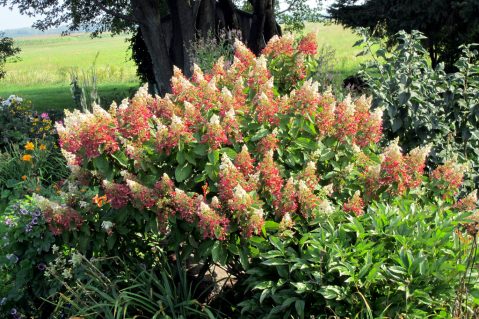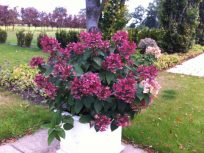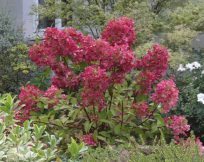Panicle hydrangea Wims Red, is a beautiful flowering bush that exudes a pleasant honey aroma.
Inflorescences have the appearance of a cone, pink, red or white-cream color.
Material Content:
Panicle hydrangea Wims Red - grade description
Hydrangea Weems Red is a shrub that reaches two meters in height. The leaves in their shape resemble an ellipse, their length on average 12 cm.

The pyramidal panicles of inflorescences have a length of 25 cm. The diameter of the flowers is 2 cm, during the year they can change color from greenish-white to red.
Hydrangea blooms from June to September. If the climate is warm, then the bush blooms until October. When hydrangea fades, a fruit is formed in place of the flower in the form of a box with seeds.
Planting in open ground
When planting a seedling, consider what the bush will look like when it grows. The condition and type of soil is important for this plant. Choose acidic or neutral soil.
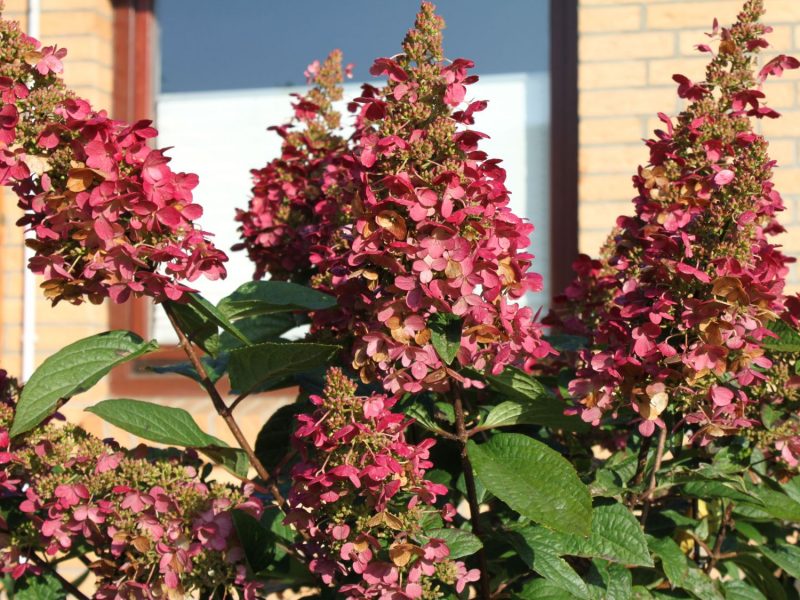
The main condition for a suitable hydrangea soil should be the following data:
- fertility
- drained land;
- sufficient humidity.
At the shrub, flowers appear on last year's shoots. If you want to have bright hydrangea flowers, plant it in acidic soil.

Important. Flowering will be most vivid if the pruning is carried out before the start of the growing season, namely in spring.
Cut the plant at the very beginning of spring, until the sap flow in the stems. If time has passed, then it is better to wait for the first leaves to appear.
Seedlings for planting should have a 4-5 year period. Hydrangea is planted in the spring, before the start of the growing season or in late autumn.
The plant loves sunny areas, but can grow in partial shade. Sandy soil is not suitable for planting.
Landing sequence:
- Preparation of the pit: its diameter should be 0.5 m, depth 0.4 m, the distance between the bushes 2.5 m.
- Fertile soil, peat, coarse sand and compost are poured into the hole. They are taken in equal parts. Potassium sulfate (30 g), urea (30 g), as well as 70 g of superphosphate are taken as fertilizer.
- The roots and shoots of the seedling are pruned.
- The bush is planted in a prepared hole and covered with earth.
- The soil in a circle around the trunk is watered abundantly.
Hydrangea Care Wims Red
Watering and feeding
Hydrangea Wims Red is very fond of moisture, so you need to water it regularly. Every week, pour at least 3 liters of water under the bush. The soil is mulched with compost or sawdust.
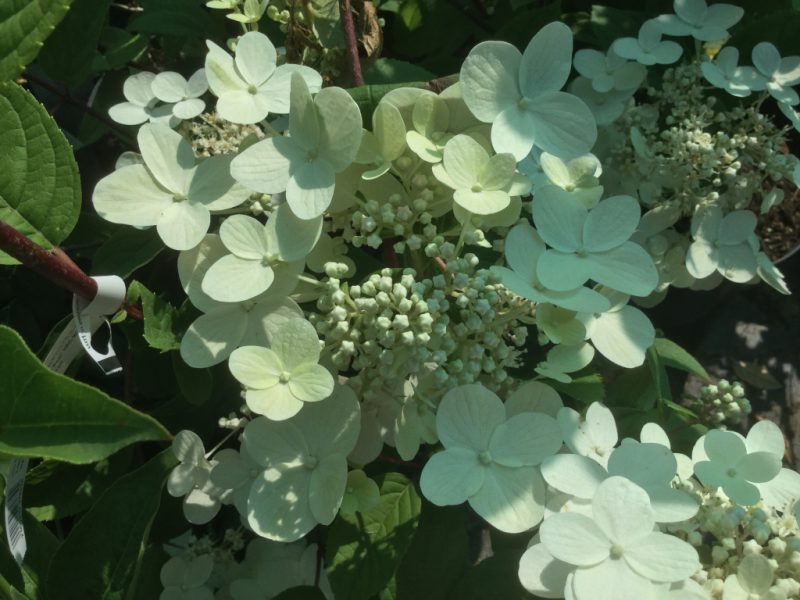
In summer, the bush is fed 3 times:
- When the snow melts, a mullein solution is introduced.
- In the middle of summer - a complex of fertilizers.
- When the plant fades, it will be already in the fall, fertilizer for shrubs without nitrogen is introduced into the soil.
In autumn, the bush is covered with peat or rotted manure. And in winter throw hydrangea with snow, so you can protect the plant from severe frosts.
Pruning
If pruning is correct, then a beautiful bush will be formed. If the plant is not cut, then the bush will become dense, and the peduncles will begin to grow smaller. This is done at the beginning of spring before the sap flow begins. If a moment is missed, you should wait for the first leaves to appear. If you start pruning during the period of active sap flow, then you should not expect good flowering in the future.

Pruning begins with the most frail and crooked branches, this is done at the very base of the bush. After that, you can proceed to the shoots from last year's flowering. They are cut for 3-4 kidneys. So a beautiful and correct crown will be formed.
How to care for Wim’s Red hydrangea in autumn, winter
The plant requires special care in the autumn-winter period. Hydrangea must be sheltered for the winter.
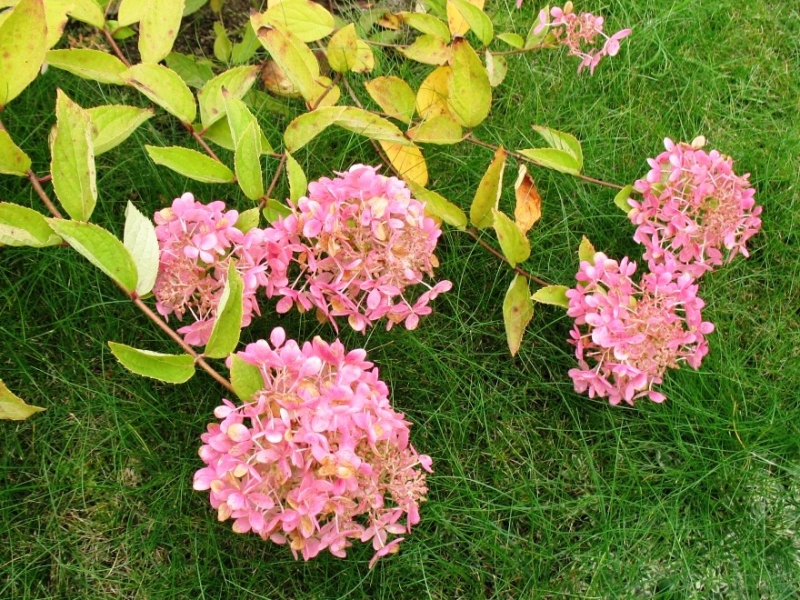
It is done like this:
- If the bush has been growing for 3-4 years, then it can tolerate frosts, and it is usually not covered. But at the same time, the temperature should not fall below -26-30 degrees. Winters the plant if the snow layer is quite high.
- Young hydrangea seedlings will have to additionally cover and mulch the trunk circle. This is done with rotted manure, peat or foliage. The layer of mulch in the root system should be at least 20 cm.
- In regions with a cold climate, not only the root system, but also the ground part of the shrub shelters. So the plant will not freeze into cold. To do this, a frame is installed on top of which a film, roofing felt or burlap is stretched. Another way to shelter is to bend the shoots to the ground, fix them and cover them with spruce branches or other material.
Reproduction of hydrangeas Wim’s Red
Despite the fact that the reproduction process is not complicated, the result is not always obtained.
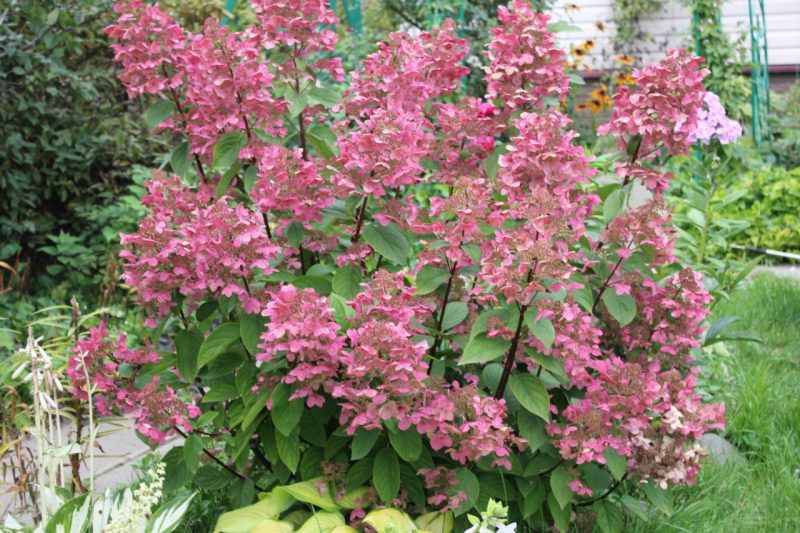
There are two ways to reproduce the Wims Red hydrangea:
- Cuttings. This is the easiest way to reproduce. It is necessary to cut off the shoot area with a few leaves. A small oblique section is made under the bottom pair of leaves. The shank is installed in water with the addition of a growth stimulator for 12 hours. After this, the stalk is planted in the soil at an angle of 45 °, sprayed from the spray with water, and on top of it a greenhouse is made of a glass jar or polyethylene. The pot is set in the shade in a well-ventilated place. After a month, the cuttings can be planted in pots with a nutritious composition.
- Layering. The option with layering is the same as that of roses, that is, a branch is dug in and fixed. The process should be carried out in the summer. Then, during the year, wait for the rooting of the branch. When this happens, it is cut off from the main plant. If at the same time there is proper care, then in the same year it will be possible to observe hydrangea flowering.
Protection against diseases and pests
Hydrangea Weems Red is resistant to various diseases and pests. It happens, in rare cases, and for the most part is associated with poor care of the plant.

Perennial may be susceptible to the following diseases:
- Chlorosis - this type of disease panicled hydrangea Wims Red is sick more often than others. In particular, if the soil in which the bush is planted has an alkaline base. You can notice the ailment immediately, on faded leaves. To protect hydrangea from chlorosis, for prophylaxis, 1-2 times a month should be watered with a solution of iron-containing salts (for example, iron chelate).
- Powdery mildew or anthracnose - with this disease, leaves are damaged, on which characteristic spots form. In this case, fungicides are necessary. There are a lot of them on sale, for example, Switch, Skor, Maxim, Horus, Ridomil Gold or Quadrice.
- Attack of the Colorado potato beetle or spider mite - insecticides, for example, Aktara, are used against them.
Use in landscape design
Vims Red bushes are used in landscape design, both in country houses and in the urban area.
The greatest effect of plants is created during the period of hydrangea color change - first from creamy white to pink, and then with a transition to a burgundy-wine tint. At one moment, flowers of all colors can be observed on the shrubbery. This is a spectacular sight.
To decorate a site with hydrangea Wims Red, you can use the following tips:
- Perennial will look good both in a single bush and in group plantings. You can create a composition.
- Perennial hydrangea is well suited for the formation of hedges, for the design of alleys and paths, for creating contrasting floral arrangements.
- Shrub can be combined with both coniferous and deciduous crops.
- If the flowers are cut, they will go to create a beautiful and original bouquet.
Once you decide to plant this shrub, you will not regret it. Hydrangea is unpretentious in leaving, will create a good mood in your garden, as it has a long flowering period.


